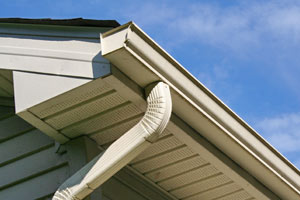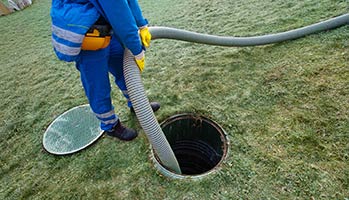Home Maintenance Topics
2-10 Maintenance Guide / Home Maintenance Topics / Exterior Maintenance
Exterior Maintenance
Roofs

- Visually inspect from the ground. Avoid walking on the roof to prevent damage and injury.
- Look for torn, broken, missing, or cracked shingles or tiles; accumulated debris; gaps in flashing; exposed joints; and obstructed vent pipes.
- Check that sealed joints around skylight frames are in good condition/not cracked.
- Look in attic for water stains on underside of roof or wet insulation. Do NOT step on insulation or ceiling, as you may be seriously injured.
- After any snow, ice, high winds, or heavy rains, check for water stains under overhang and in attic. Always call your homeowners insurance company first for any storm-related damage.
- Consult with a qualified roofing contractor, as necessary, for correction of any roofing problems.
Chimneys

- Look for open gaps between the house and chimney, cracks in mortar or stucco, and minor settlement.
- Seal gaps with an appropriate caulk and repaint to match as required. Consult with a mason to repoint or repair mortar and stucco.
- Never burn pressure-treated wood, Christmas trees, plastic, or flammable liquids in the fireplace.
- Keep flue closed when not in use to reduce cooling and heating losses.
- Clean chimney flue once a year by removing ashes as necessary and storing in a metal container to prevent fires.
Chimney Use
With the return of cold weather, before building the first fire, follow these three steps.
- Check to see if any of the “fire clay” (mortar) has fallen out and replace if necessary.
- Ensure damper works properly and closes tightly.
- Check the flue with a flashlight for soot build-up.
For heavy soot deposits, call a professional chimney cleaner.
Gutters and Downspouts

- If comfortable, inspect and clean on a ladder yourself. Never reach to clear debris. If you can’t reach it, move your ladder.
- Make sure gutters are sloped to drain toward downspouts and that water drains a minimum of five feet away from the foundation as it discharges from downspouts.
- When on the ground, inspect gutters from underneath and look for leaks, rust spots, or holes. Caulk as necessary.
- You can also hire a professional gutter cleaner.
Exterior Finish

- Look for cracks in brick, stone, and stucco. Identify any areas where mortar has fallen out. (A white powdery substance known as efflorescence may appear from time to time and is considered normal.)
- Check for warped siding, gaps in wood trim, and peeling or blistering paint.
- Sand, scrape, wire-brush, caulk, stain, repaint, and apply wood preservatives where necessary.
- Consult with a mason, as necessary, to repair cracked brick or mortar and traditional stucco problems.
- Contact a qualified contractor familiar with the manufacturer’s specifications of repair for homes clad with an Exterior Insulated Finish System (EFIS).
- Consult with a siding contractor, as necessary, to repair warped siding.
Concrete Slabs and Patios

- Examine all concrete sidewalks, patios, porches, stoops, and garage slabs for cracks, chipping, stains, scaling, or settlement.
- Consult with your local hardware store for products that can fill and repair cracks or chipping, or remove scaling residue (Automotive brake cleaning fluid works well to remove most concrete stains).
- Seal and caulk any large gaps created by minor settlement.
Grading, Drainage, and Landscaping

- Verify that the ground slopes away from the foundation.
- Stabilize any bare areas with grass, ground cover, or landscaping materials to discourage erosion. Dig out areas where sand has accumulated and fill in any low spots where necessary to reestablish drainage flow.
- Avoid overwatering plants and shrubs that are next to the foundation.
- Adjust sprinkler systems to avoid over spraying the house or causing puddles near the foundation.
- Plant trees and shrubs an adequate distance away from foundation to allow for mature spread and root systems.
- Water, fertilize, mow, and aerate your grass as necessary.
- In areas of the country with active (expansive) soils, follow maintenance and irrigation guidelines specific to your soils and foundation type. Conventional landscape practices may be inappropriate in these areas.
- For example, if your home has a pier-and-grade beam foundation and you live in a semi-arid climate, you may not be able to plant flowers or shrubs closer than five feet from the foundation, unless they have very low water requirements and can be hand or drip-line watered. Sprinkler systems may not spray closer than five feet from the foundation, and trees should not be planted closer than fifteen feet from the foundation.
- Conversely, if your home has a post-tensioned slab foundation in a moist climate, you may need to take steps to ensure that soils around foundation do not dry out excessively. Again, trees should not be planted closer than 15 feet from the foundation.
- Consult with your builder, nursery, or landscape professional, as necessary, to correct or learn more about your local soil and growing conditions.
Septic Tank & Leach Field

- Know the location of your septic tank and drain field.
- Have your septic tank inspected annually by a licensed contractor or health department official. Inspection will reveal problems before they become serious and tell you when the tank needs to be pumped.
- Periodically check the drain field for a foul odor, excessive wetness, or overly lush grass growth, which may be warning signs of a failing system.
- Never drive or park over any part of the system.
- Do not plant anything but grass over or near drain field, as tree and shrub roots may cause clogging.
Pool and Spa

- Maintain a proper water level as recommended by the manufacturer.
- Keep the water chemically balanced by regularly testing throughout the season.
- Have your pool and spa regularly maintained and serviced by a local pool and spa company.






